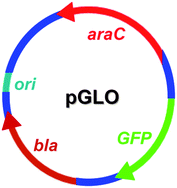This work describes an improved method for monodispersed water-in-oil droplet formation and collection using a composite microfluidic device composed of a poly(dimethylsiloxane) (PDMS) microfluidic device and a commercially available quartz capillary. The application of the method to chemical heat-shock (CaCl2-dependent) transformation of Escherichia coli (E. coli) is also presented. With this approach, tunable and uniform different-sized droplets were generated and conveniently collected into a capillary for subsequent experiments. Characterization of droplet size and formation frequency exhibits that droplet behavior is strongly dependent on the ratio (R) of aqueous phase flow rate (Qaq) to oil phase flow rate (Qo). An increase in R induces droplet size and droplet formation frequency increase, which agrees well with a theoretical calculation. To illustrate the application of this droplet-based device in biological fields, as a case study, we also apply this device to the study of heat-shock E. coli transformation. Results demonstrate that plasmid DNA can be effectively transformed into E. coli, and a similar transformation efficiency with the traditional tube-based method can be obtained. This technique provides a new way for droplet generation and easy collection, as well as functional genomics studies by taking advantage of the high throughput of droplet microfluidics.

You have access to this article
 Please wait while we load your content...
Something went wrong. Try again?
Please wait while we load your content...
Something went wrong. Try again?


 Please wait while we load your content...
Please wait while we load your content...